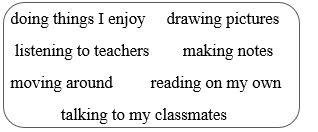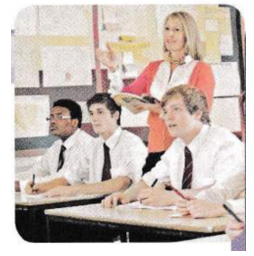1. In pairs, describe the photo.
(Theo cặp, mô tả bức ảnh.)

There are sixteen students in the class: 7 boys and 9 girls. On the front row on the left, there are two students: a boy in a grey hoodie and a girl in a blue shirt. Two lads are dressed in white hoodies. Three students with navy shirts are conversing with one another. At the final table, two females are talking, with one wearing a gray scarf on the exterior and the other wearing a pink blouse inside and a sailor shirt outside. And the instructor, who was dressed in a white shirt, black pants, and brown shoes, was seated on the top table, monitoring the entire class.
Tạm dịch:
Có 16 học sinh trong lớp: 7 nam và 9 nữ. Ở hàng đầu bên trái, có hai học sinh: một nam sinh mặc áo hoodie màu xám và một nữ sinh mặc áo sơ mi xanh lam. Hai chàng trai mặc áo hoodie trắng. Ba học sinh mặc áo hải quân đang nói chuyện với nhau. Ở bàn cuối cùng, hai bạn nữ đang nói chuyện, một người quàng khăn xám bên ngoài, một người mặc áo cánh hồng bên trong, áo thủy thủ bên ngoài. Còn giáo viên mặc áo sơ mi trắng, quần đen, giày nâu thì ngồi ở bàn trên cùng, quan sát cả lớp.

Các bài tập cùng chuyên đề
THINK! What are the best and worst things about going to school?
(Những điều tốt nhất và tồi tệ nhất về việc đi học là gì?)
4. USE IT! Work in pairs. Give your opinions on these statements using the key phrases.
(Làm việc theo cặp. Đưa ra ý kiến của bạn về những tuyên bố này bằng cách sử dụng các cụm từ khóa.)
Age of school-leavers to increase to 19
All secondary schools will have uniforms by September
SCHOOL HOLIDAYS WILL BE REDUCED TO THREE WEEKS IN SUMMER
All schools will become single-sex schools
THINK! Which things would you change about your school? Why?
(Những điều nào bạn sẽ thay đổi về trường học của bạn? Tại sao?)
4. USE IT! Work in pairs. Make a list of the advantages and disadvantages of each school. Which school would you prefer to go to?
(Làm việc theo cặp. Lập danh sách những ưu điểm và nhược điểm của từng trường. Bạn muốn học trường nào hơn?)
THINK! What job do you want to do when you leave school? What qualifications are necessary for this job?
(Bạn muốn làm công việc gì khi ra trường? Những bằng cấp nào là cần thiết cho công việc này?)
6. USE IT! Work in groups. Ask and answer questions 1-5 about the jobs in exercises 2 and 3. Then tell the rest of the class which jobs are most popular in your group.
(Làm việc nhóm. Hỏi và trả lời các câu hỏi từ 1 đến 5 về các công việc trong bài tập 2 và 3. Sau đó cho cả lớp biết công việc nào phổ biến nhất trong nhóm của bạn.)
1. Which careers involve helping people?
(Nghề nghiệp nào liên quan đến việc giúp đỡ mọi người?)
2. Which careers are more physical?
(Nghề nghiệp nào cần nhiều thể chất hơn?)
3. Which careers can make you more money?
(Nghề nghiệp nào có thể giúp bạn kiếm nhiều tiền hơn?)
4. Which careers involve studying for many years at university?
(Những nghề nghiệp nào đòi hỏi phải học nhiều năm ở trường đại học?)
5. Which job would you like to do?
(Bạn muốn làm công việc nào?)
5. USE IT! Work in pairs. Talk about the rules at your school. Which rules would you change? Would you add any? Decide which two rules are the most important.
(Làm việc theo cặp. Nói về các quy tắc ở trường của bạn. Bạn sẽ thay đổi quy tắc nào? Bạn sẽ thêm cái nào? Quyết định hai quy tắc nào là quan trọng nhất.)
A: At our school, we don't have to do homework.
(Ở trường của chúng tôi, chúng tôi không phải làm bài tập về nhà.)
B: I think more people actually do their homework because they know it helps them to learn better.
(Tôi nghĩ nhiều người thực sự làm bài tập về nhà vì họ biết điều đó giúp họ học tốt hơn.)
A: The two rules we think are most important are…
(Hai quy tắc chúng tôi nghĩ là quan trọng nhất là…)
THINK! Who do you ask for advice about problems at school?
(Ai là người bạn xin lời khuyên về các vấn đề ở trường?)
5. USE IT! Work in pairs. Ask for and give advice for each situation. Which piece of advice was the best?
(Làm việc theo cặp. Yêu cầu và đưa ra lời khuyên cho từng tình huống. Lời khuyên nào là tốt nhất?)
1. I cheated in a test.
2. Another student is bullying my best friend.
3. I'm always late for school.
I cheated in a test. What should I do?
You need to tell your teacher.
6. USE IT! Work in pairs. Read the situation, prepare and practise a new dialogue. Use the key phrases and the dialogue in exercise 1 to help you.
(Làm việc theo cặp. Đọc tình huống, chuẩn bị và thực hành một đoạn hội thoại mới. Sử dụng các cụm từ khóa và đoạn hội thoại trong bài tập 1 để giúp bạn.)
Student A: Ask your partner what the problem is: he/she looks tired. Listen, find out some more information, then offer some advice.
(Học sinh A: Hỏi bạn của bạn vấn đề là gì: anh ấy/cô ấy trông có vẻ mệt mỏi. Lắng nghe, tìm hiểu thêm một số thông tin, sau đó đưa ra một số lời khuyên.)
Student B: You're not sleeping well and you're always tired. You're worried that your school work is getting worse. You listen to music and text your friends when you should be asleep.
(Học sinh B: Bạn ngủ không ngon và luôn mệt mỏi. Bạn đang lo lắng rằng công việc học tập của bạn đang trở nên tồi tệ. Bạn nghe nhạc và nhắn tin cho bạn bè khi bạn buồn ngủ.)
THINK! What ways can people learn outside the classroom?
(Những cách nào mọi người có thể học bên ngoài lớp học?)
1. Study these ways of learning. Which ones help you to learn? Why?
(Nghiên cứu những cách học này. Cái nào giúp bạn học? Tại sao?)

SPEAKING - Asking for and giving advice
13. Choose the correct words. Then practise with your partner.
(Chọn từ đúng. Sau đó thực hành với bạn của bạn.)
Raul: Hi, Layla. Is everything all right? You don’t look very happy.
Layla: I’m really worried about next week's chemistry test. I haven't really understood anything we've done.
Raul: Have you (1) ____________ to anyone about it?
Layla: No. Can you give me any (2) ____________? It’s all such a disaster!
Raul: Listen, (3) ____________ panic.
Layla: But I know I’m going to fail the test. (4) __________ should I do?
Raul: You (5) __________ to speak to Miss Wilson. Teachers are there to help us, you know.
Layla: Yes, you're (6) ___________. I'll go and see her right now.
1. a. speak b. spoken c. spoke
2. a. advice b. plan c. information
3. a. do b. don't c. did
4. a. What b. How c. Why
5. a. should b. can c. need
6. a. right b. true c. good
2. In pair, describe your class.
(Theo cặp, mô tả lớp học của bạn.)
4. Survey the class. Find someone who ….. ?
(Khảo sát lớp học. Hãy tìm người nào mà ….. ?)
|
|
Student’s name |
|
1. lives in a three-storey house? |
|
|
2. has got a younger brother? |
|
|
3. has got a pet in their house? |
|
|
4. has got their mother as a teacher? |
|
|
5. usually goes to school on time? |
|
|
6. is interested in listening to music? |
|
|
7. loves taking photos of nature? |
|
|
8. went to a sports class last year? |
|
5. Tell the class about your survey results.
(Nói với cả lớp về kết quả khảo sát của bạn.)
Internet Search (Tìm kiếm Internet)
Did you know... (Bạn có biết không...)
are there university ice cream making courses, for example at the University of Reading in the UK?
(Có những khóa học làm kem ở trường đại học, ví dụ như ở Đại học Reading ở Anh?)
Find out where the Carpigiani Gelato University is and what courses it offers.
(Tìm hiểu xem Đại học Carpigiani Gelato ở đâu và trường cung cấp những khóa học nào.)
Speaking
1. Look at the photo and answer the questions.
(Nhìn vào bức ảnh và trả lời các câu hỏi.)

Where are they? How much time do you spend studying every day?
(Họ ở đâu? Bạn dành bao nhiêu thời gian cho việc học mỗi ngày?)
Beginnings – Endings
(Mở đầu – Kết thúc)
1. Read the beginnings. Which starts with a poem? a statement? a rhetorical question?
(Đọc phần mở đầu. Cái nào bắt đầu bằng một bài thơ? một câu trần thuật? một câu hỏi tu từ?)
1. Do you ever think about what your ideal school looks like? I do it all the time!
2. My ideal school is a huge one with a big playground and lots of convenient classrooms.
3. What is the IDEAL school?
"A school is a place to learn!"
That is what everyone says.
(RoboRabbit)
NOTE: You can start/end your presentation with a rhetorical question/a poem/a statement/a humour to grab the audience's attention.
(Bạn có thể bắt đầu/kết thúc bài thuyết trình của mình bằng một câu hỏi tu từ/một bài thơ/một câu trần thuật/một câu chuyện hài hước để thu hút sự chú ý của khán giả.)
2. Read the endings. Which contains a rhetorical question? a humour? a statement?
(Đọc phần kết. Câu nào chứa câu hỏi tu từ? một câu chuyện hài? một câu trần thuật?)
1. You can learn a lot in such a unique school.
2. They say you should love learning. If I study in my ideal school, I will definitely love learning.
3. Would you like to be in my ideal school? I know I would!
Organising ideas
(Tổ chức ý tưởng)
3. List the notes under the headings.
(Liệt kê các ghi chú dưới các tiêu đề.)
gym science lab quiet road library quiet area maths club
swimming pool canteen short presentations wide street
study groups sports clubs lots of classrooms playground
beautiful scenery equipment for sports and art science club
computer lab not so many students in a class
little homework trips to museums/art galleries
modern devices in classrooms (computers, projector, etc.)

NOTE: Organising ideas is an important part of preparing a presentation. It helps you to decide which ideas to include, make sure that you don't forget any of your main points. Organising ideas makes it easier for the audience to follow your presentation.
(Sắp xếp ý tưởng là một phần quan trọng trong việc chuẩn bị một bài thuyết trình. Nó giúp bạn quyết định nên đưa vào những ý nào, đảm bảo rằng bạn không quên bất kỳ điểm chính nào. Sắp xếp ý tưởng giúp khán giả theo dõi bài thuyết trình của bạn dễ dàng hơn.)
4. Use your ideas from Exercises 1-3 to prepare your presentation.
(Sử dụng ý tưởng của bạn từ Bài tập 1-3 để chuẩn bị bài thuyết trình của bạn.)






